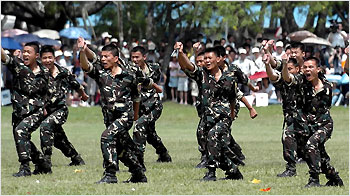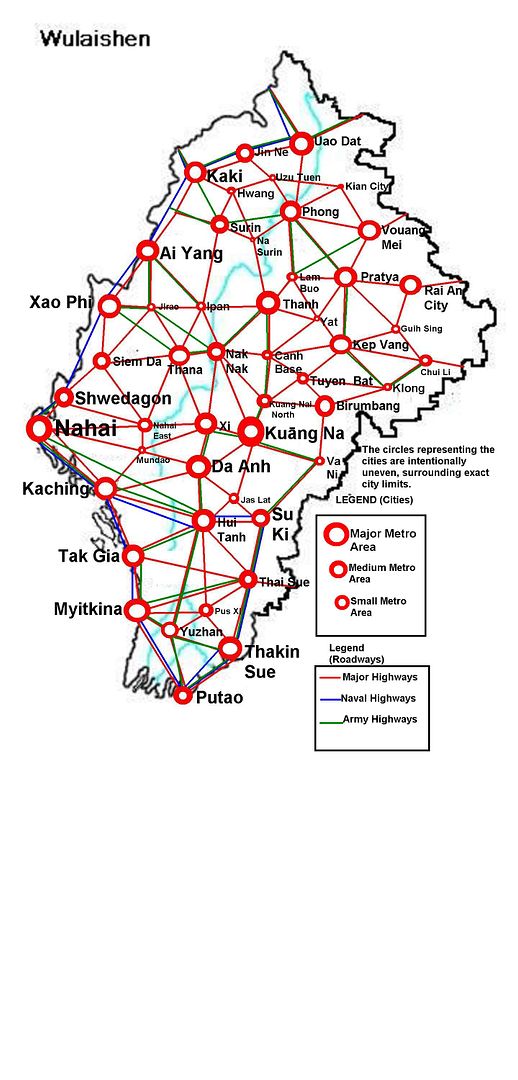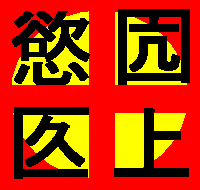Wulaishen
| |||||
| Republic Under the Dragon. | |||||
| Mapclick for map [] | |||||
| Spoken Languages - Official - Unofficial |
Vietnamese,Burmese, Wulaishenese English | ||||
| Capital | Phaī Rhā | ||||
| Five largest metropolitan agglomerations Nahai Vishnu (100 million metro) | |||||
| President | Vi Huá Ñei | ||||
| Prime Minister | Lai Çanh Gaō | ||||
| Area - Total - % water |
680,375 km² 9.1% water | ||||
| Population - Total (4 February 2006) |
4.5 billion (Indochina: 1st) | ||||
| Establishment | 22 June 2004 | ||||
| Government type | Bicameral-parliamentary | ||||
| Nation type | Presidential republic | ||||
| National animal | Elephant | ||||
| National flower | Jade Orchid | ||||
| National tree | Ginseng | ||||
| GDP (2005) - Total (USD) - GDP/capita (USD) |
$106,320,955,750,000 $41,933 | ||||
| Currency | 1 Nmoi Rubli = 100 fen]] | ||||
| National Charter of Rights | Wulaishenese Banner of Annexation | ||||
| Time Zone | MMT(UTC+6:30) | ||||
| International Abbreviations - sport - government |
WUL GPRW | ||||
| Pronunciation (IPA) | /Wu Lai Shen/ | ||||
| Naval Craft Classification - Military - Civilian |
WMS CWCS | ||||
| National Anthem | Song of the Banner | ||||
| CHDI (2006) | 0.919 (high) | ||||
| Internet TLD | .wul | ||||
| Calling Code | +95 | ||||
Contents
Location, Size, and Extent
Wulaihshen is situated in Southeast Asia between about 92 degrees and 101 Degrees East (about 600 miles) an 10 degrees and 28 degrees North (about 1,200 miles). It is bordered on the North by unclaimed lands, and on the East by Cute Thai Girl; on the Southwet by the Andaman Sea, and on the West by the Bay of Bengal.Wulaishen has an land area of about 281,030 sq. mi., and a lengthy coastline (900 miles) extending along the Bay Of Bengal and the Andaman Sea to the South and Southwest.
Topography
Wulaishen is divided into four topographic regions: (1) a mountainous area in the north and west, ranging from 6,000 to over 23,000 feet in altitude, and including the Arakan coastal strip between the Arakan Yoma mountain ange and the Bay of Bengal; (2) the Shan Yi highlands over in the East, a deeply dissected plateau averaging over 3,000 feet in height and extending to the south into the Tenasserim Yoma, a narrow strip of land extending all the way down to the Malay Peninsula, In the Southeast; (3), central Wulaishen, a principal area of industrial activity, bounded by the Salween river in the East, and the Irrawaddy River and it's Tributaries, the Chindwin, as they were once named, in the west; and (4)the fertile delta and parts of the lower valley regions of the Irrawaddy and Sittang rivers in the south, covering an area of about 24,200 sq km., and forming one of the region's great rice production areas.Several large harbors are located along the long coastline, and it's many islands.
Climate
Wulaishen has a mainly tropical climate with three seasons; the monsoon or rainy season, from the middle of May to Mid October; the hot season, generally from april through May and from October through November, immediately following is the wet season, and the cool season, from December to March.Rainfall during the monsoons season totals almost 200 inches in Northern Wulaishen, particualrly in the Arakan and Tenassarim coastal region, and 100 inches in lower Wulaishen and Thakin Sue.Central Wulaishen, called the dry zone, in the area of Arakan Loma, receives 25 to 35 inches, and Thakin Sue, one of the larger cities in the heavily populated area, about 30 inches. Temperature from the cool to hot seasons range fro 60 degrees to 100 degrees.In lower Wulaishen and from less than 60 degrees to more than 100 degrees.The climate in upper Wulaishen, particularly in altitudes ranging from 1,000 to 4,000 feet, are the most temparte thoughout the year, while lower Wulaishen, is the most humid.
Population and Ethnicity
According to the Wulaishenese National Census, tooken in 2007, Wulaishen had a population of rougly 4.5 Billion people, the most in the Indochina region, and a popoulation density of 600 people per square mile, making also one of the densest. It is also important to know that Wulaishen is 80% Urban. The Wulaishenese, ethnically related to the Vietnamese and Tibetans, comprise about 75% of the Wulaishen's total population.In remote times, the Vietnamese, migrants from the Viet tribes to the far east, descended the Irrawaddy valley and Intermarried with the previously settled Burmese and Thai peoples.Since then however, many other migrant peoples from the northeast and northwest have settled in Wulaishen;The Jiral Montagnard of Vietnam, the Kachins, and the Hans are some of the more numerous.Although much ethnic fusion has taken place between peoples and the Wulaishenese, most of the migrant groups continue to live in distinct cultural entities, in in the hustle and bustle of Wulaishenese Metropolises.According to recent estimates there are in Wulaishen about 800 million Shans, 2,000,000 Karens and Kyis, 40,000,000 Chins.There are also 30,000,000 Indians and Pakistanis, 35,000,000 Chinese, 20,000,000 Japanese and a smaller number of African/American Wulaishenese.
Religion
The Decree of Annexation guarantees freedom of religion in Wulaishen, but 65% of the people are Hinayana or Theravada Buddhists, but it is equally remarkable that the Wulaishenese Government announces Christianity as the National Religion.The Yan An Christian Association, created by legislation in 2001, serves to coordinate Christian activities of all the various denominations in the country, and sends missonaries via train or highway, to the far-out urban areas in the East of the nation to spread Christianity thoughout the nation.so far, Wulaishenese families have kept to their Buddhist family traditions, but let a little Christian insight into their lives, like a majority of the Buddhists in Wulaishen dont profess Buddhism as their primary religion, but rather, as a way to live their lives. They practice Buddhist rituals, but go to church on Sundays, and are baptized in Christ.Theres also a small Taoist population, and a growing Hindu population.
 Wulaishenese Rural Christians
Wulaishenese Rural Christians
Transportation
International land transportation throught Wulaishen, is reliable, and even as intimidating as he formidable North to South Mountain ranges are, the Wulaishenese have shown the ingenuity to build through them (tunnels), ot over them, in some areas. Historically, Wulaishen has been very dependant on it's well maintained highway systems, and river ferry systems along the Irradwaddy, supplemented by the airplane. Lai Canh Bao enacted a massive reform of the Highway systems in 2000, signaling the way for over 80,000 miles over highways.Despite it's rugged terrain, Wulaishen has always maintained a highly developed highway system.Ralway track mileage of the Wulaishen Railways(WR) amounted to 12,909 mi. of main and branch lines in 2007.Feeding into the main WR system are 200 private company lines, comprising 5,000 miles, of which are all magnetified.High Speed lines are common in Wulaishen, and have been sucessful in taking the load off the sometimes overwhelming highway systems in Wulaishen. Lai Canh Bao also enacted the construction of a National Military Highway System, to increase Wulaishenese Military readiness by procuring a quick and efficient way to move equipment from Inland bases to ports, and vise versa, no civilian vehicles are allowed on the highway, and and fined according to how far away from the cities they are.There are separate Army, and Naval Highways. The Army highways are paved 7 lanes wide, to be as efficent in troop and equipment movement possible.The Naval Highways are paved 10 lanes wide for the same reasons, and to provide routes for fuel transfers for ships and aircraft. The Naval highway is also the widened as a landing strip, to provide a makeshift Runway for Wulaishenese Military Aircraft Naval and Air Force.
Language
A Majority of Wulaishenese speak Vietnamese, and English. A growing number are learning about their native roots and learning Tribal languages in High School, or learning Burmese, as Wulaishenese are partially Burmese.Wulaishenese, as the indigneous language is called, is spoken by relatively few besides Teachersm Diplomats, and Government workersm but nevertheless, is identified as one of the Official Languages.
Communications
Wulaishen is known to be an internet savvy nation. Despite this, post offices are common, and increasingly popular among Wulaishenese. The Wulaishenese Postal Services operate 18,234 post offices. Telephone and mobile phone services are provided the Wulaishenese company, AsiaCom, along with many other American and Japanese phone services, like NipponTalk, and Cingular Wulaishen. There are approximately 3 Billion telephones in Wulaishen. The average Wulaishenese has one home telephone, two mobile phones, a Television, and a computer in their homes, according to the Wulaishenese Census and Excise Service. Nearly every house has a computer in Wulaishen. Those that dont are often a short walk away from Internet Cafes.
History
The origins of the Wulaishenese Nation are still unknown; mythology places the beginning in as early as 600 BC, When the Wu tribes where fighting the lowland Chinese.Modern Wulaishen can easily be traced back to the Phoenix rebellion, in the year 1960, where imprisoned Vietnamese General Trep Phi Quyn started a rebellion in the prisons under the administration of Ho Chi Minh in Vietnam, before they routed the French out, and the Communist takeover was thriving. Ho Chi Minh was but a inspirational figure in Vietnam. Trep Phi Quyn and an army of 1,000 Prisoners of War broke out of the Sin Kai Song prison in the Vietnamese City of Long Xuyen, marched West to Cambodia, attempting to rout the Khmer Rouge movement. After failing miserably, With Trep having lost 600 troops due to starvation, he stayed in Cambodia and remained in a secretive isolation, quietly amassing an army of over 6,000, and moving farther westward to Burma, without even a single supported lost. After marching all the way to the former Burmese Empire Capital of Phai Rha, and defeating the Burmese forces single handedly with supporting forces from the Karen Liberation Army, he manager to form what is now known to us as the Modern Republic of Wulaishen.
Government
Wulaishen follows the parlimentary system in accordance with the Decree of the Banner, in 2000, which drastically reformed the character of the goverment.The most significant change has been the transfer of sovereign power from the Dictator, as Wulaishen was formerly Communist.The Dictator formally and benevolently "ruled" with the assistance of a cabinet appointed by her, to the people who know rule through their elective powers.The President, while capable of immense administative power, leaves that duty chiefly to the prime minister, who acts as a "spokesman, or woman from Her, or Him.The President is defined as a symbol for the unity of the Wulaishenese people.The constitution provides for the supremacy of the Wulaishen People's Cabinet, or parliament, as the legislative branch for the Wulaishenese Government as well as for the separation of the legislative, executuve, and judicial powers. It also provides the guarantee of civil liberties.The executive branch is headed by the president, who elects a prime minister selected by the cabinet among it's leadership.The cabinet consists of the President, the Prime Minister, and 11 to 16 Prefetural Ministers, who represent eash of Wulaishens's 16 Prefectural Divisions, each aslo headinga government agency or ministry board, such as the Wulaishenese Defense Ministry, and the Econominc planning board. At least half of the ministers most be selected from the WPC, and the WPC is collectively responsible for electing to the main Parliament.Upon a vote of nonconfidence in the Wulaishenese Golden House, as it is called, the cabinet must resign en masse, with a new prime minister designated by the President, or the Golden House may be dissolved and natl elections called for, following which the government and his cabinent must resign.The WPC is bicameral.The Golden House (The lower house) has a membership of 1,197 with terms of office of two to three years, except that all terms end upon dissolution of the House.Representatives elected from 230 districts called Golden Consitituencies, being either, citywide nor nationwide in extent,.These are drawn up on a population basis. The term of office is six years, with one half elected every three years.The lower house holds primary power.Legislation may be initiated by ant member or by the cabinet and must recieve approval of this house and the Golden House.In the upper house fails totake action within 60 days of recipt of legislation from the lower house.The budget, drawn up by the cabinet, must be submitted first to the lower house, or if agreement cannot be reached by the upper house, or if the upper house fails to take action within 30 days, the decisioni of the lower house beccomes the desision of the Wulaishenese People's Cabinet.Eligibility for election to the Jade House(the lower house) requires a minimum age of 22 with no recideny requirements; for the Golden House, a minimun age of 30.Suffrage is universal, the voting age being 18 years with a three year recidency required.The Banner of Annexation granted the suffrage to women.
Economy
Wulaishen's economy is the most advanced in Indochina.Wulaishen is the first Indochinese Nation to develop a large urban middle class industrial society.It is the only Indochinese Nation to recieve a sharp increase in birthrates, while receiving further increase in per capita income. The Wulaishenese economy is primarily industrial.Although the government and commerce still employs a large percentage of the nation's workforce.The number of farmers has been decreasing sharply in proportion to the increase in industry and commerce.In recent years, income differentals between the agricultural and nonagricultural sectors have become far more prounouced.This has been accompanied by a rise in the secondary production and tertiary sectors of the economy which has further aggravated agriculture's position by attracting an increasing number of members of agriculautral household to supplement work in industry.

Phwedagon, A sign of Wulaishen's growing commercial strength; skylines change overnight.
Military
In the year 2001, Wulaishen adopted a universal part consciption-part volunteer providing for two year's service in the Wulaishenese Armed Forces, or Public Security Force.The yearly conscription and volunteer is estimated at about 900,000 men and women.The army, officially called the Wulaishenese People's Army, has been divided into four field armies.It's total strength is estimated at about 30.5 million.In addition, there is an equally well trained reserve force, whose basic numbers are around 200 million.The navy is advanced, and large, and growing, the estimated total tonnage of war vessels numbers in the billions.The Air Force, known as the Wulaishenese People's Air Force, operates a number of indigenous and imported aircraft.The WPAF, was estimated at 23,000 planes, mostly fighters and logisitics craft. The Wulaishenese military is well trained and combat ready, and can exert their power across anywhere on the globe, have a number of carrier battle groups, and specially developed roadways for troop movement, Wulaishen is generally regarded as having the most advanced and combat ready fighting force in Indochina.
 Wulaishenese F-2 at Dat Phai AFB
Wulaishenese F-2 at Dat Phai AFB
 Wulaishenese Soldiers on march.
Wulaishenese Soldiers on march.

Wulaishenese Soldiers are very well trained.



